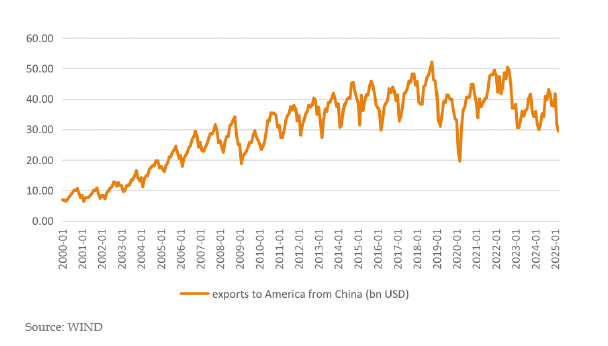A More Proactive "Going Global" Approach to Counter Trump's So-Called "Reciproca
Currently, the Trump Administration has implemented a series of impactful foreign policies, most notably the controversial "reciprocal tariffs" introduced in April 2025. Historically, this marks the inevitable culmination of a century-long cycle in the United States (US) trade policy. While the US economy remains relatively resilient in the short and medium term, retaining stronger capacity to withstand fluctuations than most developed countries. China's manufacturing capacity is unparalleled globally. Therefore, China's global deployment of goods and capital should not only adhere to general economic principles, but also reflect its unique feature of production capacity, exploring a "going global" model tailored to its industrial and supply chain ecosystems. In shaping the new global economic and trade landscape, China aims to create a global production capacity model aligned with its industrial structure.
Trump's Foreign Policy: Chaotic in Appearance, Strategic in Objective
At the outset of his second term in February 2025, Donald Trump introduced "reciprocal tariffs", mandating equal tariff rates between the US and its trading partners, alongside proposed levies on countries using value-added tax (VAT) systems. The April 2 official announcement of these "reciprocal tariffs" triggered significant shocks across global trade, finance, and flows of industrial information, capital, and goods. Volatility in the three major US stock indices neared 2008 global financial crisis levels, while the Trump Administration spent April repeatedly revising the policy and issuing ambiguous cabinet statements, including 180-degree reversals within 48 hours. This challenged long-held perceptions of the US governance as professionally consistent and rational. Analyzing Trump's trade policy through short-, medium-, and long-term perspectives reveals both historical inevitability and personalistic traits, requiring evaluation beyond surface-level chaos.
"High tariffs" is an industrial rescue mechanism. The United Kingdom of Great Britain and Northern Ireland(UK), a nation shaped by successive industrial revolutions since the 17th century, exemplifies tariff policies as tools for domestic industrial intervention. From the 16th to the 18th century, it embraced mercantilist policies, prioritizing trade surpluses via high tariffs to accumulate wealth. During the 18th to 19th century, as the UK led the First Industrial Revolution, it gradually reduced or even eliminated tariffs on certain industrial imports to secure reciprocal market access for British goods. Encountering rising trade competition from the US and Germany in the 20th century, it signed the Ottawa Agreement(1932), establishing "imperial preference"to strengthen commonwealth trade ties. Post World War II, with diminished industrial clout, it joined the US-led free trade regime. This historical cycle, trade protection → free trade → multilateral trade → ally trade → new system integration, highlights how industrial powers adapt policies to shifting global status. The US is currently transitioning from the "multilateral trade" to "ally trade", a process likely spanning decades. Trump's high-tariff measures, therefore, represent a strategic response to the US's relative industrial competitiveness decline, rooted in this cyclical logic.

The Trump Administration's governance style, marked by presidential and cabinet capriciousness, represents a historically striking departure from norms. In navigating the high-tariff phase driven by the declining US competitiveness, its measures blend populism, personal whim, and cabinet unpredictability, starkly contrasting historical precedents. First, decentralized and arbitrary decision-making. Second, the rise of "isolationist" foreign policy. Trump's skepticism of traditional trade frameworks traces back to his book The Art of the Deal, where he criticized the then US trade policies for enabling large surplusesin countries like Japan, which were detrimental to American national interests—a critique that planted the earliest seeds of his "America is losing" narrative. Later, as a media personality witnessing Japan's 1990s industrial peak, he solidified his belief that "free trade" often favors competitors. This worldview shaped his pledge to make allies shoulder "fair shares" of security and economic burdens, rejecting what he deems US subsidization of global free-riding.
Trump's policies are constrained by resources and conflicting objectives. Compared to his first-term cabinet, which was dominated by establishment figures or political outsiders, Trump's second-term team includes numerous non-establishment loyalists: staunch protectionist nationalists, Wall Street-aligned growth advocates, and Cold-War-minded ideologues. These factions represent incompatible values and core interests, creating stark internal divisions on trade policy. For instance, hardliners like Commerce Secretary Howard Lutnik and National Trade Council advisor Peter Navarro advocate aggressive conservatism to reduce the US trade deficit, while moderates such as Elon Musk and Treasury Secretary Scott Bessant favor gradual tariff adjustments. Recently, moderate momentum has grown, with Republican leaders, including former GOP leader Mitch McConnell, seeking bipartisan legislation to curb Trump's unilateral authority to escalate tariffs.
Trump's foreign policy explicitly targets the establishment of tariff-based trade alliances rather than a universal trade war. In early April, his focus on rebuilding domestic manufacturing was evident, using tariffs as leverage to pursue objectives, including reducing trade deficits, increasing fiscal revenue, and rebuilding defense supply chains, even at the risk of a "prisoner's dilemma" of mutual harm. The ultimate aim was to foster medium- to long-term conditions for manufacturing repatriation. However, the May 8 US-UK Economic Prosperity Agreement signals a pivot toward forming strategic tariff alliances, particularly in sectors with minimal industrial competition with the US. This framework agreement reveals the Trump Administration's willingness to lower "reciprocal tariffs"to rapidly secure more deals, though the UK's concessions have drawn widespread domestic criticism. Academia's extensive analysis of these policies' "political economy" often generates "public opinion noise," requiring dispassionate evaluation to gauge their actual impacts.
Trump'

